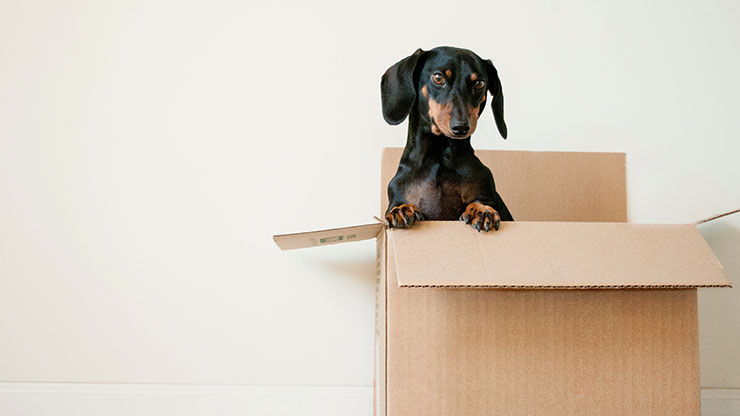
Four Paws and a Move: How to Successfully Move With Your Pooch
Moving can bring about a lot of overwhelming emotions at one time, such as excitement, stress, exhaustion, and even fear. Although we’re feeling all these things ourselves, we at least know what’s happening. Imagine you’re a dog or cat, feeling scared and stressed because everything is changing and not knowing what will happen next. It would be great if we could talk to our pets and explain the situation, but unfortunately, we can’t. However, there are ways that we can mitigate the stress and make the moving process less stressful for humans and canines alike.
How to Identify if Your Dog is Stressed
You know your dog can read your emotions, but you can read theirs, too, if you know the signs. Per VCA Animal Hospitals, here’s what to look for and what it means.
- Barking and whining more than usual can be a self-soothing behavior.
- Rapid blinking or dilated pupils and ears pinned back against their heads can signal anxiety.
- Panting even though they aren’t hot or haven’t been exercising.
- Excessive shedding when there isn’t a seasonal transition.
- Yawning that is more intense or prolonged than a tired or bored one is a sign of stress.
- Hiding behind you, circling, and even digging can be signs of stress, too.

How to Help Your Pup De-Stress
Once you’ve identified stress in your dog’s behavior, you want to fix it for them, right? Here are some things you can do to help relax your dog. And as a bonus, some of them will help you relax, too.
- Resist the urge to over-compensate. Your dog needs things to be normal. Don’t just start giving your pup extra treats or food for no apparent reason. If you want to give them extra treats, make them earn it as you did before.
- Take them for a walk. Even though you’re extra busy and thoroughly exhausted, a walk will do wonders for helping your dog de-stress. You don’t have to walk too far or too fast. Just get outside and have some bonding time with your dog.
- Give your dog some puppy play time with fellow canines. This option is good if you are too tired for a long walk but want your dog to get some exercise and social time. However, remember that not all dogs are suited for dog parks. In some cases, they can actually increase a dog’s anxiety.
- Have a relaxing moment with your pet as you provide a little doggie massage. Dog Training Nation notes that massage can help your pet relax, as with humans. Plus, petting your dog releases serotonin and dopamine, which help us feel better, too. So it’s a win-win solution.

Keeping Calm Even After the Move
You can do things to relieve the stress you and your pet may be feeling in a new place. A few tips for relieving that could be:
- Find a veterinarian you can trust. Ask the neighbors or people you see with their dogs which veterinarian they use. While at the vet, if you haven’t had your dog microchipped yet, this would be a critical time to do so. In their confusion, they could quickly become lost.
- Reduce stress by unpacking quickly. Clutter - including the chaos involved after a move - is a big factor in making us feel stressed in our homes. It stands to reason the same would be true for your pet. As you unpack the boxes, remove them to a place where they will be out of sight until you can recycle them.
- Have one installed if your new home doesn’t have a fenced yard. It will take a little time, but it will bring you peace of mind when you let your dog out. Plus, a perimeter fence can increase the value of your property when you choose to move out. You may even want to add a decorative fence to the front yard.
- Find a place you both enjoy taking a walk. Then stick to that one for a while until your dog begins to feel at home there and in the new house and immediate surroundings. Dogs need the sense of security that having a routine brings. So try to take those walks at a regularly scheduled time and try not to vary it too much in the first couple of weeks.
- If you find yourself walking your dog at night or before dawn, look into lighting on a tall pole, like a residential-sized street lamp, that you can install around your property to create a safer exercise environment and a clearer path. It’s safer, and it’s much easier to see whether or not your pup has completed its business.
Settling in with Fido
Moving to a new place with your pet creates some extra challenges and many benefits. After all, who else but a pet owner gets to take their best friend with them when they move? Take the time to learn about the signs of stress, and then take steps to reduce potential anxiety at your new location. It’s an excellent practice to microchip your pup in case they get out, but reduce that likelihood by installing a fence and getting into an exercise routine with your dog, so you both get to know the neighborhood better. And if you’re looking to add to your pack, contact Continental Kennel Club, Inc. to find a new four-legged friend for your family.










